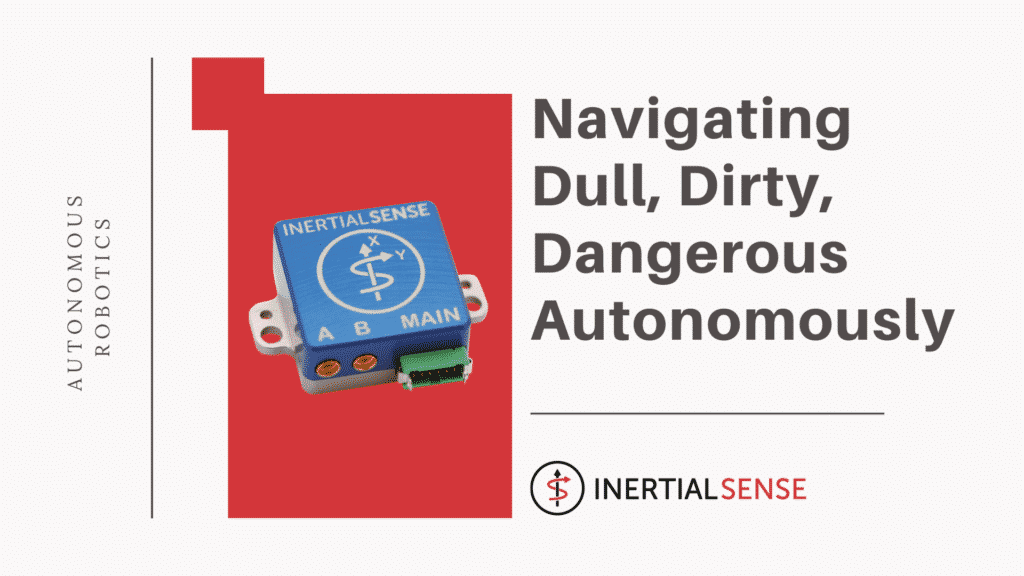
Navigating Dull, Dirty, Dangerous Autonomously
Robots and automated systems are ideally suited to take on repetitive, dirty, and dangerous jobs. These systems have already proven their value in commercial environments. For example, Arkansas State University has implemented Husqvarna autonomous mower systems that have significantly reduced the cost of maintaining their grounds. Autonomous navigation presents some real challenges, especially as the need for these technologies expands. Here are some of the most critical factors that will affect the implementation of autonomous robotics now and in the future.
Understanding Autonomous Navigation
According to a report released by the White House in December 2016, autonomous robotics systems will increase productivity in many sectors of the economy. Artificial intelligence is already making real progress in aiding autonomous navigation for flying robots and drones, with The Drive reporting that an AI simulation is consistently defeating human opponents in virtual dogfights. However, translating this type of success to the real world will require advanced navigation solutions that address the challenges of autonomous robotics and navigation effectively.
How Does Autonomous Navigation Work?
Understanding the necessary steps to allow robots and automated devices to take over many dull, difficult, and dangerous jobs can shed some light on the challenges involved in developing autonomous robot navigation systems. Three primary elements go into the development of autonomous robotic navigation:
- Guidance
- Navigation using GPS and other systems
- Control
These tasks work together to allow autonomous robotics systems to perform appropriately in real-world situations.
Guidance
Guidance determines the desired trajectory for the vehicle or robot. This includes targeting, adjustments to speed and acceleration, and turning as required to reach the designated target.
Navigation
During the movement of the robot or autonomous device, navigation provides information on the precise speed and velocity of the vehicle. Attitude is also vital for autonomous navigation for flying robots.
Control
Control modules and software manage the forces needed to propel robots and to ensure the greatest degree of stability when traversing various types of terrain or in the air.
Each of these three elements is necessary to achieve the desired results for navigational autonomy in practical applications. Collectively referred to as GNC, guidance, navigation and control are of critical importance when planning robotics and navigation projects.
Challenges of Autonomous Robotics and Navigation
While several practical hardware solutions are available for autonomous robot navigation and vehicle navigation requirements, a standard for software systems is still not in place. This has created some issues for GNC in the autonomous navigation field:
- Data filtering is essential to separate the relevant information from the large data sets collected by the sensor hardware. Kalman filtering, which is also called linear quadratic estimation, is one solution to this problem. Some inaccuracies in the data filtering process still occur when using this method.
- Currently, no standardized plug-and-play solution is available that spans industries. This means that autonomous navigation for flying robots and spacecraft uses different software standards than autonomous vehicle navigation and that different autonomous mower systems may operate under very different software standards, making it difficult to integrate autonomous navigation devices and robots into one system.
- Regarding the issue of GPS-denials, the University of Illinois puts it best, “In a GPS-denied environment, such as on a river where there are overhanging canopies or trees, the signal becomes weak, so we want to develop an autonomous vision-based navigation algorithm that can be used without GPS or in conjunction with weak GPS signals to navigate through these unknown areas.”
- Visual simultaneous localization and mapping (Visual SLAM) is still in the first stages of development. Simply put, it is a process that allows autonomous navigation systems to determine the attitude and position of a sensor in the context of its immediate surroundings by mapping the environment around the sensor. When GPS systems are intentionally spoofed by hackers or deny service, these positioning systems can provide inaccurate data to autonomous robotics implementations. Visual SLAM can provide a solid fallback position. In some environments, it may serve as the primary method for autonomous vehicle navigation.
The right autonomous robotics software solution will address data filtering, standardization and GPS denials in a practical way. At Inertial Sense, we are revolutionizing the way in which autonomous movement is implemented across a wide range of industries.
The LUNA Software Platform
The LUNA platform by Inertial Sense provides a true plug-and-play solution for companies interested in adding automation to their equipment.
- LUNA uses Visual SLAM technology to increase accuracy even when GPS systems are not available or are inaccurate through human error or intentional spoofing.
- Our standardized software allows interoperability between different hardware systems and creates a standard for software in vehicle and flight automation.
- Inertial Sense sensors allow for dual-GPS antenna and RTK capabilities paired with kalman data filtering requirements to increase accuracy and relevance for the information collected by our precision sensors.
Our expertise and experience makes it simple to manage projects ranging from autonomous mowers to spacecraft and everything in between.
Inertial Sense offers autonomous navigation for a world in motion. To learn more about our solutions, visit us online or give us a call at 1-801-515-3750. We look forward to working with you to build a brighter, more automated future and take on the challenges of dull, dirty, and dangerous jobs with the most advanced solutions in robotics and navigation technology.

Exploring The Challenges of Autonomous Robotics and Navigation with Inertial Sense

